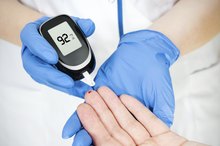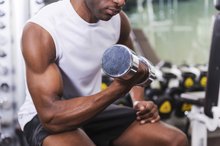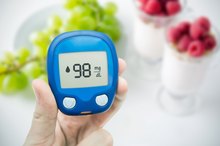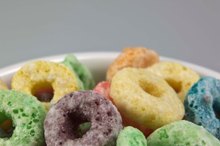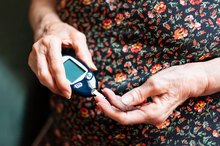Does the Body Burn Fat When You Are Hungry?
When you are hungry, your blood sugar, or glucose, levels are low. The body reacts to this condition by releasing glucagon, a hormone that triggers cells to release nutrients into the bloodstream. The first nutrient the body releases into the bloodstream is stored sugar. So, when you are hungry, you normally burn stored sugar.
Food Metabolism
When you eat a normal meal, the food breaks down into smaller components in the digestive system. Carbohydrates break down into glucose, protein converts to amino acids and fat converts into a protein-covered fat molecule that can enter the bloodstream through the lymph system. When nutrients enter the bloodstream, the pancreas produces insulin that helps cells absorb the nutrients. Once the cells have absorbed the majority of nutrients, hunger sets in, and the pancreas produces glucagon to make the cells release nutrients into the bloodstream.
- When you eat a normal meal, the food breaks down into smaller components in the digestive system.
- Carbohydrates break down into glucose, protein converts to amino acids and fat converts into a protein-covered fat molecule that can enter the bloodstream through the lymph system.
Glucose First
Low Blood Sugar in Non-Diabetics
Learn More
Glucose is the fastest nutrient to enter the bloodstream from the digestive system. It is also the easiest energy source for the body to use. When you are hungry, the body uses glucose stored as glycogen as an energy source before it breaks down fat. Unless you consume protein in excess, the body does not use protein as an energy source to any significant extent. So, when hunger occurs, the body turns stored sugar into energy.
- Glucose is the fastest nutrient to enter the bloodstream from the digestive system.
- When you are hungry, the body uses glucose stored as glycogen as an energy source before it breaks down fat.
Empty Sugar Stores
In some conditions, the body’s glycogen stores are empty. If you have just been exercising for an extended time period, your body will have used up its stores of glycogen. When you feel hungry, the body will break down fat and use that as a source of energy. If you follow a strict low-carbohydrate diet, such as the initial phases of the Atkins diet, you also burn fat when you feel hungry. A strict low-carbohyrate diet supplies very few carbohydrates. As a result, the body’s stores of glycogen will be virtually empty, and the body will switch from using glucose as its primary fuel to using fat.
- In some conditions, the body’s glycogen stores are empty.
Insulin Resistance and Diabetes
How Does Glucose Move into a Cell?
Learn More
In special circumstances, the body cannot use glucose as an energy source. The most common conditions where this happens include insulin resistance and type 1 and type 2 diabetes. In type 1 diabetes, the pancreas does not produce sufficient amounts of insulin for the cells to absorb glucose from the bloodstream. With insulin resistance and type 2 diabetes, which is a severe case of insulin resistance, the pancreas produces insulin, but the insulin produced does not manage to signal to the cells when glucose is available in the bloodstream. When these conditions go untreated, blood sugar will increase to dangerously high levels, but in spite of the high blood sugar levels, you will feel hungry. To stay alive, the body will burn fat.
- In special circumstances, the body cannot use glucose as an energy source.
- With insulin resistance and type 2 diabetes, which is a severe case of insulin resistance, the pancreas produces insulin, but the insulin produced does not manage to signal to the cells when glucose is available in the bloodstream.
Related Articles
References
- American Heart Association: About Diabetes
- Virtual ChemBook: Overview of Metabolism
- MedlinePlus: Glucagon
- American Diabetes Association: Diabetes Basics
- U.S. Centers for Disease Control and Prevention. Insulin resistance and diabetes. Last reviewed August 12, 2019.
- Wilcox G. Insulin and insulin resistance. Clin Biochem Rev. 2005;26(2):19–39.
- Ritchie RH, Zerenturk EJ, Prakoso D, Calkin AC. Lipid metabolism and its implications for type 1 diabetes-associated cardiomyopathy. J Mol Endocrinol. 2017 May;58(4):R225-R240. doi:10.1530/JME-16-0249
- Volpi, E. and Dickinson, J.M. (2015). Protein metabolism in health and diabetes. In International Textbook of Diabetes Mellitus (eds R.A. DeFronzo, E. Ferrannini, P. Zimmet and K.G.M.M. Alberti). doi:10.1002/9781118387658.ch16
- Colorado State University. Pathophysiology of the Endocrine System. Physiologic effects of insulin.
- University of Berkley, California. Endocrine Pancreas.
Writer Bio
Dr. Berit Brogaard has written since 1999 for publications such as "Journal of Biological Chemistry," "Journal of Medicine and Philosophy" and "Biology and Philosophy." In her academic research, she specializes in brain disorders, brain intervention and emotional regulation. She has a Master of Science in neuroscience from University of Copenhagen and a Ph.D. in philosophy from State University of New York at Buffalo.
